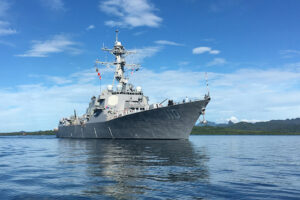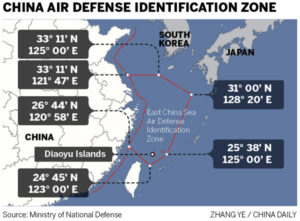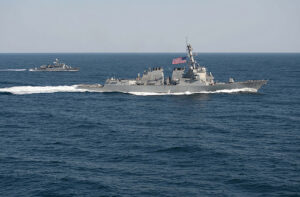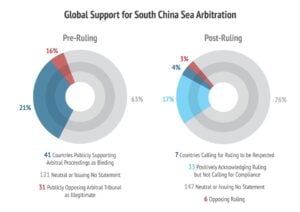Chinese Threaten Japan, Australia Over South China Sea; Time For US FON Ops?
Posted on

USS William P. Lawrence
UPDATED: Adds Excellent CSIS Study On International Support For Chinese Claims
WASHINGTON: What are China’s intentions in the South China Sea? It’s a question intelligence analysts, diplomats and the senior leadership of the United States and its Pacific allies are all asking in the wake of a range of increasingly belligerent and threatening comments and actions by the rising global power.
Perhaps most worrying is that the Kyodo News Agency and other Japanese outlets have reported variations of a story that China’s ambassador to Tokyo Cheng Yonghua said in late June that the Japanese Self Defense Force would “cross a red line” if they took part in Freedom of Navigation operations in the South China Sea. “(China) will not concede on sovereignty issues and is not afraid of military provocations,” Cheng is reported to have told Japanese officials.
Then Chinese military aircraft, including a bomber, penetrated South Korean airspace yesterday. The region includes part of the Chinese ADIZ declared in 2013. South Korea expanded its own ADIZ as a counter to Beijing. No country accepts China’s assertion of the ADIZ.

China’s new “Air Defense Identification Zone,” which covers the Japanese-controlled Senkaku Islands — called the Diaoyus by China.
Earlier this month, a fleet of 14 government vessels accompanied several hundred fishing vessels into the East China Sea in waters that Japan claims as its Exclusive Economic Zone.
The first sharp bilateral provocation in this pattern came when the Chinese government-owned and operated newspaper Global Times said in an editorial that China should fire on any Australian vessel participating in Freedom of Navigation operations in the South China Sea: “If Australia steps into the South China Sea waters, it will be an ideal target for China to warn and strike.”
But the editorial didn’t just include the threat. The paper went on to describe Australia as “a unique country with an inglorious history. It was at first an offshore prison of the UK and then became its colony, a source of raw materials, overseas market and land of investment. This country was established through uncivilized means, in a process filled with the tears of the aboriginals.”
Are these the signals of a power bent on war? Are these the actions of a surging power, one eager to change the balance of power in the South and East China seas? And how does the United States — the lone power capable of leading a regional military response, should it come to that — react?

USS Lassen performed FON op through Chinese-claimed waters in 2015
This all plainly comes in large part in reaction to the ruling by the International Court of Arbitration (this links to excellent Center for Strategic and International Studies analysis on global support for China’s position on South China Sea claims) that “there was no legal basis for China to claim historic rights to resources within the sea areas falling within the ‘Nine-Dash Line'” that the Peoples Republic of China claims. China made clear from the beginning it would not accept the tribunal’s ruling and said it would prosecute its claims to the South China Sea.

CSIS study results
But the vigorous Chinese reaction is clearly driven by more than this. “Let’s remember that Xi is going to have to replace almost the entire Politburo Standing Committee. We’ve not seen this situation since 1992. What kinds of political pressures does Xi face?” asks Dean Cheng, Chinese military expert at the conservative Heritage Foundation. How much of this action is Xi playing to nationalist elements in China? It’s very difficult to tell so far.
Cheng believes that China, as has Russia, will practice hybrid warfare to push, prod and test the United States and its allies. “I would expect them to be harassed by Chinese fishing boats, to be buzzed by Chinese planes (not necessarily military), to be shadowed and perhaps ‘locked on’ by Chinese coast guard vessels (many of which are cascaded PLA Navy ships). Are WE prepared to be constantly harassed, perhaps ‘bumped’ and collided with?” Cheng wonders.
He thinks it very likely that Chinese fishermen will use rifles to shoot at foreign ships and Chinese fishing boats or coast guard vessels might ram foreign ships or throw themselves in front of them to incite reactions.
Of course, China has not gone that far recently. He points to the fact that the Chinese “haven’t started shooting. All this is making big scary faces to scare people off.”
For that reason — and others — Cheng is critical of the Obama Administration’s response. “What the hell have we done? We’ve done nothing, absolutely nothing. This administration is giving the Chinese a free pass and it’s therefore no surprise the Chinese are pushing hard.”
And no country has the global diplomatic and military muscle to directly counter the PRC. “The Chinese can out-muscle Australia, and they have a decent chance at intimidating the Japanese,” he says.
What has the administration done so far? The US has performed three Innocent Passage FON operations since October last year: the USS Lassen sailed past the Chinese artificial holding on Subi Reef in the Spratlys. The USS Curtis Wilbur sailed within 12 nautical miles of Triton Island in the Paracels chain near Vietnam. And the USS William P. Lawrence came within 12 nautical miles of the Chinese installation on Fiery Cross Reef in the Spratlys.
Also, in early July, the USS Nimitz’s Carrier Strike Group 5 conducted “routine operations” in the South China Sea. “Our forward-deployed ships are operating here to maintain the seas open for all to use,” Rear Adm. John D. Alexander was quoted in a statement at the time. So while not technically a FON op, the intention was clear.
The United States should perform classic Freedom of Navigation operations, with military ships and airplanes sailing and flying through international waters and airspace and challenging Chinese claims to the area, Cheng believes. So far, we have performed what are called Innocent Passage operations. They help maintain and declare the right of all navies to access the waters and islands within the area the Chinese call the Nine Dash Line, but they do not serve the same purpose as a military ship proceeding through the area and launching helicopters, or using targeting radar or performing military drills.
Cheng called on the administration to convey America’s support for international law and the tribunal’s ruling, as well as for its allies, at the G-20 Summit on Sept. 3-4. He called on President Obama and Secretary of State John Kerry to raise the issue with China during the summit.
It’s interesting that Air Force Secretary Deborah Lee James and Army Chief of Staff Gen. Mark Milley are in the Pacific region this week.
Subscribe to our newsletter
Promotions, new products and sales. Directly to your inbox.
